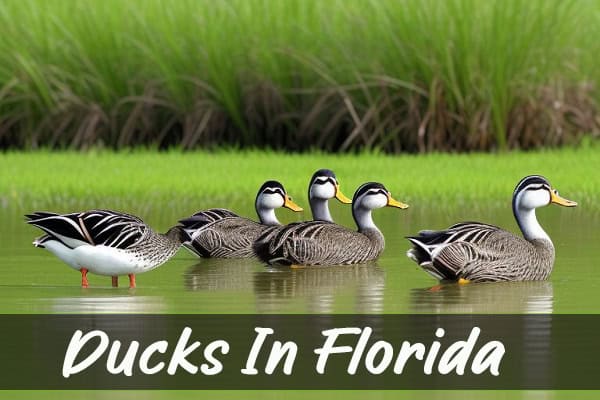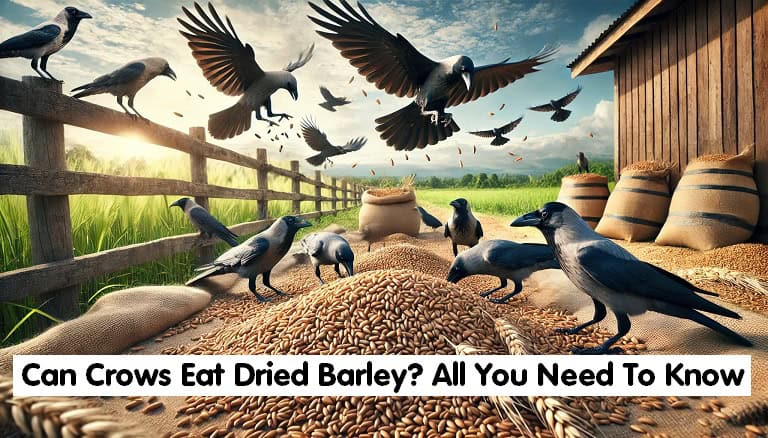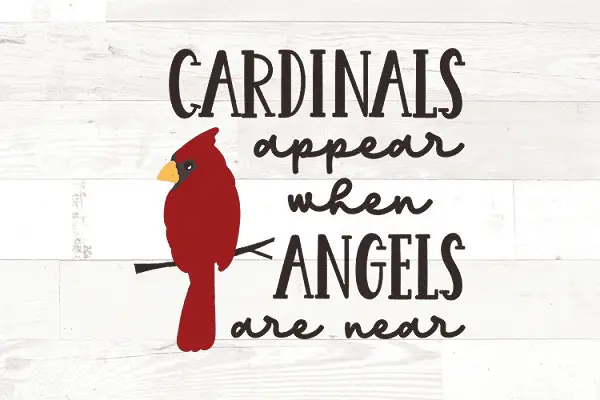Discover 11 Most Stunning Ducks in Florida (With Pictures)
Ducks In Florida is home to almost 550 bird species, making it a paradise for bird lovers. With its varied habitats and subtropical climate, it’s perfect for birdwatching. Among these, 34 species of ducks stand out, each with unique feathers that make them fun to watch.
From the well-known Mallard to the rare Ruddy Duck, these waterfowl can be seen in wetlands, lakes, and by the coast. But do you know how to tell these 34 duck species apart and where to find them? Let’s start a journey to learn about Florida’s diverse duck populations.
1. Mallard Duck
- Scientific name – Anas platyrhynchos
- Lifespan – 27 years (maximum recorded)
- Size – (50 to 65 cm)
- Weight – (750 to 1600 g)
- Wingspan – (75 to 100 cm)
The mallard duck is a common sight in Florida, known for its unique look and widespread. It’s considered the most widespread duck species globally. You can see them all year in the Sunshine State.
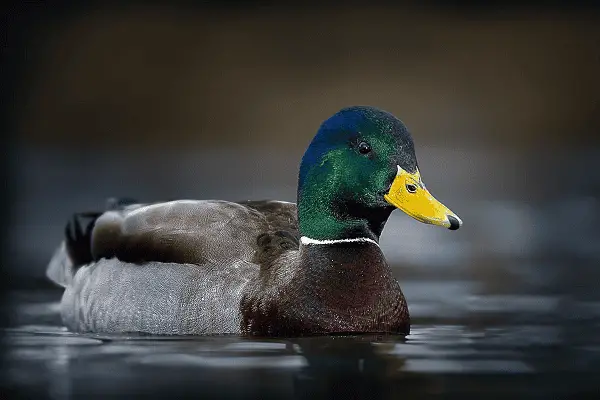
Description
Mallard males have a shiny green head, a yellow beak, and a thin white collar. They also have a dark grey back, a brownish-white belly, and a purplish-brown breast. Their black lower back and upper wings are grey with a blue speculum and a white border. The underwings are whitish.
The females are brown with dark brown-edged feathers. They have a blue speculum with a white border and grey beaks with a hint of orange.
Where to Find
You can find mallards all over Florida all year. They’re common in many places, from city parks to wetlands. A great spot to see them is Fort De Soto Park, a favorite for birdwatchers and nature lovers.
“The mallard duck is a ubiquitous sight across Florida, known for its distinct plumage and widespread presence.”
Mallards are not just beautiful; they’re also important to the ecosystem. They’re one of the most common ducks, adding to Florida’s diverse bird life. If you’re out in a park or a wildlife preserve, look for these ducks. They’re sure to catch the eye of anyone who loves birds.
2. Ring-necked Duck
- Scientific name – Aythya collaris
- Lifespan – 20 years (maximum recorded)
- Size – (39 to 46 cm)
- Weight – 1 (490 to 910 g)
- Wingspan – (62 to 63 cm)
The ring-necked duck is a medium-sized diving duck that visits Florida in the winter. You can see them in many wetland areas, like ponds, marshes, lakes, and bays.
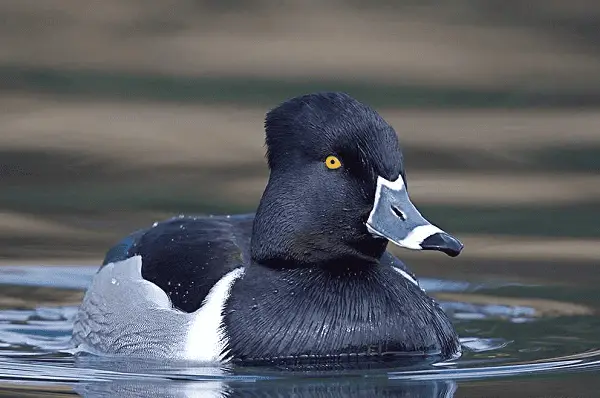
Description
Breeding males have a black head, breast, and back, with gray sides and a white crescent near the shoulder. Their eyes are golden-yellow, and they have a white ring around the bill. Non-breeding males look grayish-brown.
Females are rich brown with a pale cheek, a white patch near the bill, and a whitish eye-ring. These ducks are smaller than Mallards or Redheads but similar in size to Lesser Scaup. They fly with dark wings and a grayish, not white, wingstripe.
They like to be in small groups or pairs and dive to eat mollusks, invertebrates, and submerged plants.
Where to Find
Ring-necked ducks prefer smaller waters like beaver ponds, small lakes, marshes, cattle ponds, and flooded fields. They are very common in Florida during the winter. You can see them at places like Merritt Island National Wildlife Refuge, Circle B Bar Reserve, Lake Apopka, and Viera Wetlands.
Some ring-necked ducks also breed in Florida. In 1964, a nest was found near the St. Johns River in Cocoa. In 1979, a pair of four young was seen in Alachua County. They like to nest on “floating islands” in places like Orange Lake, which makes them good for breeding in certain areas.
| Duck Species | Distinctive Features | Habitat Preferences |
|---|---|---|
| Mallard Duck | Recognizable by their green heads, yellow bills, and brown bodies | Found in a variety of wetland habitats, including ponds, lakes, and marshes |
| Ring-necked Duck | Identified by their distinctive white ring around their bill and dark head | Prefer deeper, permanent bodies of water like lakes and ponds |
| Ruddy Duck | Known for their stiff, spiky tail feathers and bright blue bills during breeding season | Inhabit shallow, freshwater wetlands and marshes |
Florida’s ducks highlight the state’s rich biodiversity and the need to protect its habitats. Whether you’re into birdwatching, nature, or just love these birds, Florida’s ducks will surely amaze you.
3. Ruddy Duck
- Scientific name – Oxyura jamaicensis
- Lifespan – 13 years (maximum recorded)
- Size – (35 to 43 cm)
- Weight – (300 to 850 g)
- Wingspan – (56 to 62 cm)
The ruddy duck is a beautiful bird found in Florida’s lakes and ponds. Males stand out with their chestnut body, black crown, and white cheeks. Females have a brown color with rufous tints.
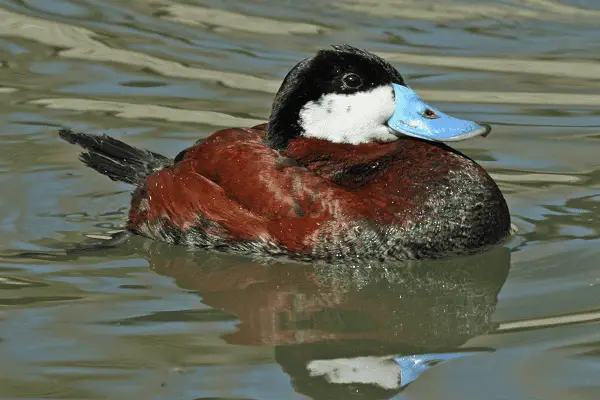
Description
Ruddy ducks lay the largest duck eggs relative to their body size. They are also known for being aggressive during breeding season. They defend their territory against other birds.
Florida has a long history with the ruddy duck, dating back 11,000 years. The oldest recorded ruddy duck was found in Oregon, after being banded in British Columbia in 1951.
Where to Find
If you want to see a ruddy duck in Florida, look in the state’s lakes and coastal waters. Florida has nine breeding records of these ducks, with a tenth in Hillsborough County.
Great places to see them include the Everglades National Park, Circle B Bar Reserve, and Lake Apopka. They are most active in winter when they gather in wetlands and ponds.
“Ruddy Ducks are likely to continue nesting in impoundments due to wetlands restoration projects and other wetlands creation in west-central Florida.”
The ruddy duck is a must-see for birdwatchers in Florida. Keep an eye out, and you might spot this fascinating waterfowl.
4. Mottled Duck
- Scientific name – Anas fulvigula
- Lifespan – 13 years (maximum recorded)
- Size – (46.9 to 57.2 cm)
- Weight – (699 to 1241 g)
- Wingspan – (80 to 87.2 cm)
The mottled duck is a fascinating bird found in Florida’s wetlands and coastal areas. It has a dark buff-brown body and a pale buff head, with both sexes looking similar. The back and flanks have brown streaks, and the crown is dark brown. A unique dark brown line goes through the eye, and the underwings are white with a dark blue speculum.

There’s a slight difference in how males and females look. Males have a bright yellow beak, while females have a black beak with an orange tip. Females are also darker than males.
In Florida, you can see mottled ducks all year in wetlands and coastal areas. Places like the J.N. “Ding” Darling National Wildlife Refuge are great spots to watch them. They like to eat at the surface or tip up for submerged plants, diving only when needed.
Mottled ducks are about the same size as mallards, with a strong build and a short neck. They are bigger than blue-winged teal but smaller than common mergansers. They are roughly the size of a crow or a goose.
5. Wood Duck
- Scientific name – Aix sponsa
- Lifespan – 22 years (maximum recorded)
- Size – (47 to 54 cm)
- Weight – (454 to 862 g)
- Wingspan – (66 to 73 cm)
The wood duck is a true sight to behold in Florida’s wetlands and flooded woodlands. This bird has a complex and iridescent plumage that catches the eye. The male wood duck has a green-crested head a chestnut chest and a lower neck. It also has bold markings all over its body.

Its belly and throat are stark white, and the underwings are soft grey. The flanks have a warm, buff color, and the eye is bright, fiery red. The bill is a mix of white and red.
The female wood duck is mostly brown with a greyish head. She has delicate white speckles on her breast and a white eye ring that fades behind the eye. The speculum, or wing patch, is deep blue with a white edge, a key feature of this species.
Where to Find Wood Ducks in Florida
Wood ducks are common in Florida and stay all year. They live in swamps, flooded woodlands, and by rivers, creeks, and ponds. Myakka River State Park is a great place to see them in their natural habitat.
Wood ducks are quite skittish in Florida, making them hard to photograph. Photographers need patience and care to capture their beauty.
“The wood duck is one of the most colorful North American waterfowl with a mixture of iridescent blues, greens, and purples.”
6. Northern Pintail
- Scientific name – Anas acuta
- Lifespan – 22 years (maximum recorded)
- Size – (51 to 76 cm)
- Weight – (500 to 1450 g)
- Wingspan – (80 to 95 cm)
The northern pintail is a common winter visitor to Florida’s wetlands and estuaries. It’s known for its dark brown head and neck. The male has a striking white neckband that turns into a pure white breast and belly.
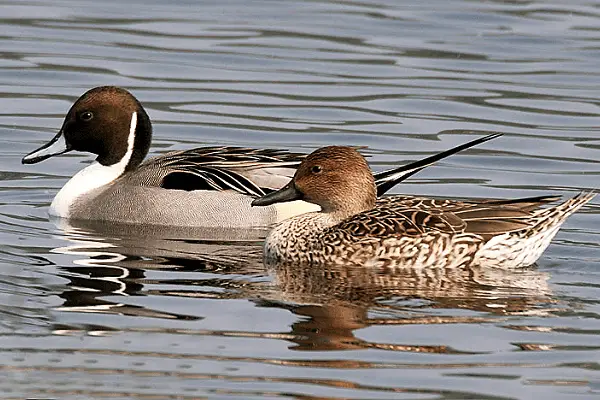
Description
The male northern pintail has a lovely grey upper body. It sports a green speculum and a white rear border. Its long, dark undertail feathers and sleek tail feathers make it look elegant. The bird’s bill is light blue.
The female is mottled light brown with a tan head and a brownish-bronze speculum. Northern pintails tip their heads underwater to find aquatic seeds and insects. They often form large flocks and mix with other duck species outside of breeding season.
These ducks are bigger than the Green-winged Teal but smaller than the Mallard. They’re about the size of a crow to a goose. In Florida, they’re often seen at the Saint Marks National Wildlife Refuge. Look for them in lakes, wetlands, estuaries, salt marshes, and bays.
7. Blue-winged Teal
- Scientific name – Spatula discors
- Lifespan – 23 years (maximum recorded)
- Size – (36 to 41 cm)
- Weight – (230 to 545 g)
- Wingspan – (56 to 62 cm)
The blue-winged teal is a small but powerful duck found in Florida’s wetlands and marshes. It’s known for its unique look. Males have a reddish-brown belly and breast with dark spots. Their heads and necks are sleek dark gray, with a white crescent on their face and dark brown backs.

Females have a more subdued brown look with dark streaks on their heads and a dark crown. Their underparts are buff with brown speckles, and their wings have a green speculum and a blue-gray patch.
Description
These ducks are the second most common in North America, after the mallard. They are smaller than some other ducks but are agile and fun to watch. They are about 16 inches long and have a wingspan of about 2 feet.
They make an amazing migration, traveling up to 7,000 miles to reach South Florida for the winter. Their breeding area stretches as far north as Alaska. This shows how resilient and adaptable they are.
In Florida, blue-winged teals are rare nesters but common visitors, especially in winter. They live in various wetlands, often with other ducks.
“Blue-winged teal are extremely common and occur all over the state. They may be seen throughout the year but are more abundant in winter.”
8. Green-winged Teal
- Scientific name – Anas crecca
- Lifespan – 20 years (maximum recorded)
- Size – (31 to 39 cm)
- Weight – (140 to 500 g)
- Wingspan – (52 to 59 cm)
The green-winged teal is a small, fast-flying duck found in Florida’s wetlands and marshes. It’s known for its green wing patches and cinnamon-colored head. Birdwatchers and hunters love to see these ducks.
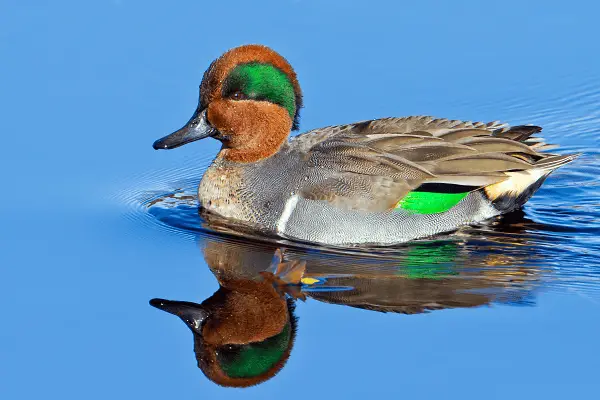
This duck is one of the smallest in North America. It’s 12-16 inches long and weighs 12-16 ounces. The male has a gray body, white stripe, and green head with a cinnamon face. The female has brown feathers with a yellowish tail stripe.
These ducks live in many wetland types, like shallow marshes and flooded fields. Myakka River State Park is a great place to see them.
Green-winged teal are great foragers. They use their special bill to eat small plants and bugs. They often feed by tipping up in shallow water or picking food from puddles.
9. Northern Shoveler
- Scientific name – Spatula clypeata
- Lifespan – 16 years (maximum recorded)
- Size – (44 to 51 cm)
- Weight –(400 to 820 g)
- Wingspan – (69 to 84 cm)
The northern shoveler is a unique and fascinating duck species found throughout Florida. They have a large, spoon-shaped bill and striking plumage. These ducks are a delight to see in their natural habitats.

Description
The male northern shoveler has a vivid green head, black back, and chestnut-colored belly and flanks. Its large, dark bill is nearly as long as its head. The female has a brown body and a blue patch on the wing.
These ducks are larger than an American coot but smaller than a mallard, about the size of a crow. They have a wingspan up to 30 inches and a bill up to 2.5 inches long.
Northern shovelers have a unique way of foraging. They sweep their bills side to side in shallow wetlands. This helps them find aquatic invertebrates and seeds in the water. They can live in many aquatic habitats, like shallow wetlands, coastal marshes, rice fields, and sewage lagoons.
These ducks are monogamous and form strong bonds. In fact, one male northern shoveler lived for at least 16 years and 7 months, found in California in 1969.
Despite being found globally, the northern shoveler is common in Florida. They can be seen all year, but more so during winter.
“The northern shoveler’s large, spoon-shaped bill is a true marvel of adaptation, allowing it to thrive in a wide range of aquatic habitats.”
When birdwatching at Merritt Island National Wildlife Refuge or exploring local parks, look out for the northern shoveler. Its unique look and behavior are a highlight for nature lovers in Florida.
10. Black-bellied Whistling-duck
- Scientific name – Dendrocygna autumnalis
- Lifespan – 10 years (maximum recorded)
- Size – (47 to 56 cm)
- Weight – (652 to 1020 g)
- Wingspan – (76 to 94 cm)
The black-bellied whistling duck is a captivating bird that’s spreading out in Florida. It’s known for its brown top parts, black belly, and tawny-brown neck. These birds are becoming more common in the Sunshine State.
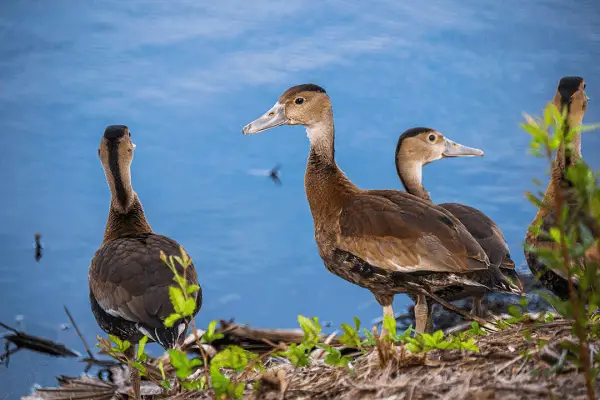
These ducks are medium-sized, about 21 inches tall, and weighing around one and three-quarters pounds. They are unique in how they breed, laying 9 to 18 eggs at a time. Both parents take turns keeping the eggs warm, which takes 25 to 30 days.
After the eggs hatch, the ducklings can stand, walk, and feed themselves quickly. They stay with their parents for up to six months.
Black-bellied whistling ducks live in southern California, Mexico, Texas, and Central Florida. Researchers found more of them at the Corkscrew Swamp Sanctuary than 15 years ago. They first showed up in Florida in 1990 and have spread out since then.
They can be seen in Wisconsin too, and they visit the Sanctuary almost half the year. They are most active from June to September.
Experts think the ducks are moving north because of warmer temperatures and better living conditions. To help these birds, the Corkscrew Swamp Sanctuary is making 1,000 acres of land better for them and other waterbirds. Keeping track of these changes is important for understanding how climate change affects their migration.
“The number of quadrangles occupied by whistling-ducks increased dramatically from the first to the second Florida Breeding Bird Atlas.”
Check Our Previous Articles:
11. Fulvous Whistling-duck
- Scientific name – Dendrocygna bicolor
- Lifespan – 11 years (maximum recorded)
- Size – (45 to 53 cm)
- Weight – (712 to 1050 g)
- Wingspan – (85 to 93 cm)
In Florida’s wetlands, you might see the Fulvous Whistling duck. It looks similar to the Black-bellied whistling duck. It has brown upperparts, a black belly, and a tawny-brown lower neck and chest. It’s known for its white wing patch, greyish head, and reddish-pink bill and legs. This duck likes to perch in trees, adding to Florida’s diverse bird life.

The Fulvous Whistling duck is not very common in Florida but can be found all year. It likes wetlands like marshes. You might see it at Circle B Bar Reserve, Lake Apopka, or Lake Hancock Outfall Wetlands. In January 2015, 32 of these ducks were counted, showing they can be found in different places in Florida.
The number of Fulvous Whistling-ducks in Florida has grown a lot. There were 220% more breeding records in the two Breeding Bird Atlas surveys. The Breeding Bird Survey also shows more of these ducks. As they grow in number, they’ll find more homes in Florida’s wetlands. This means birdwatchers will have more chances to see these interesting ducks.
Frequently Asked Questions:
Q1. What ducks are common in Florida?
Common ducks in Florida include Mallards, Mottled Ducks, Wood Ducks, and Black-bellied Whistling Ducks.
Q2. What are Florida ducks called?
Florida ducks include native species like the Mottled Duck, as well as various migratory species that visit the state.
Q3. Why are there so many Muscovy ducks in Florida?
Muscovy ducks are abundant in Florida because they were introduced for ornamental purposes and have thrived in the state’s warm climate and urban environments.
Q4. Is it legal to catch ducks in Florida?
It is legal to hunt ducks in Florida during specific seasons and with the proper licenses and permits. However, catching or trapping ducks is generally not allowed.

